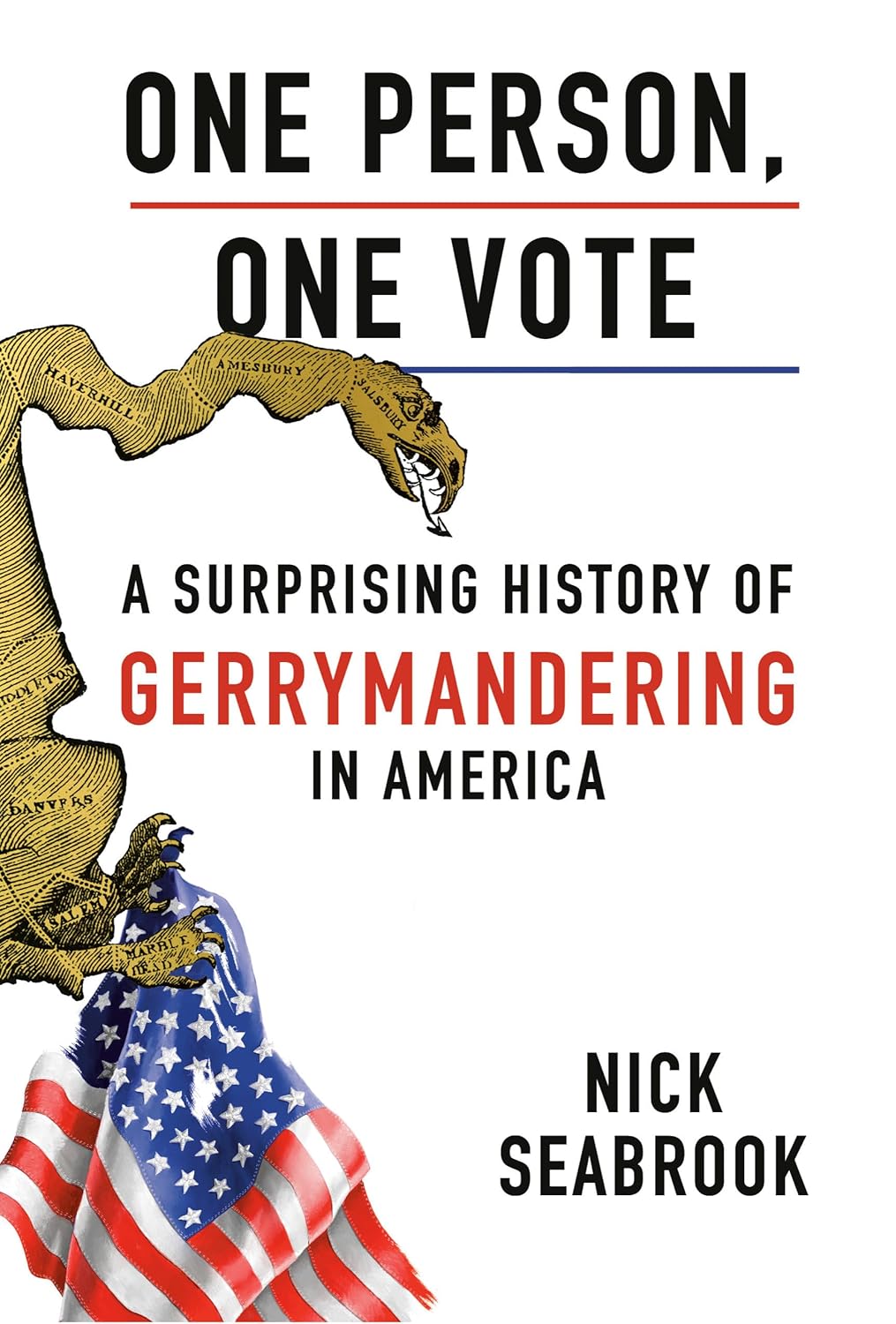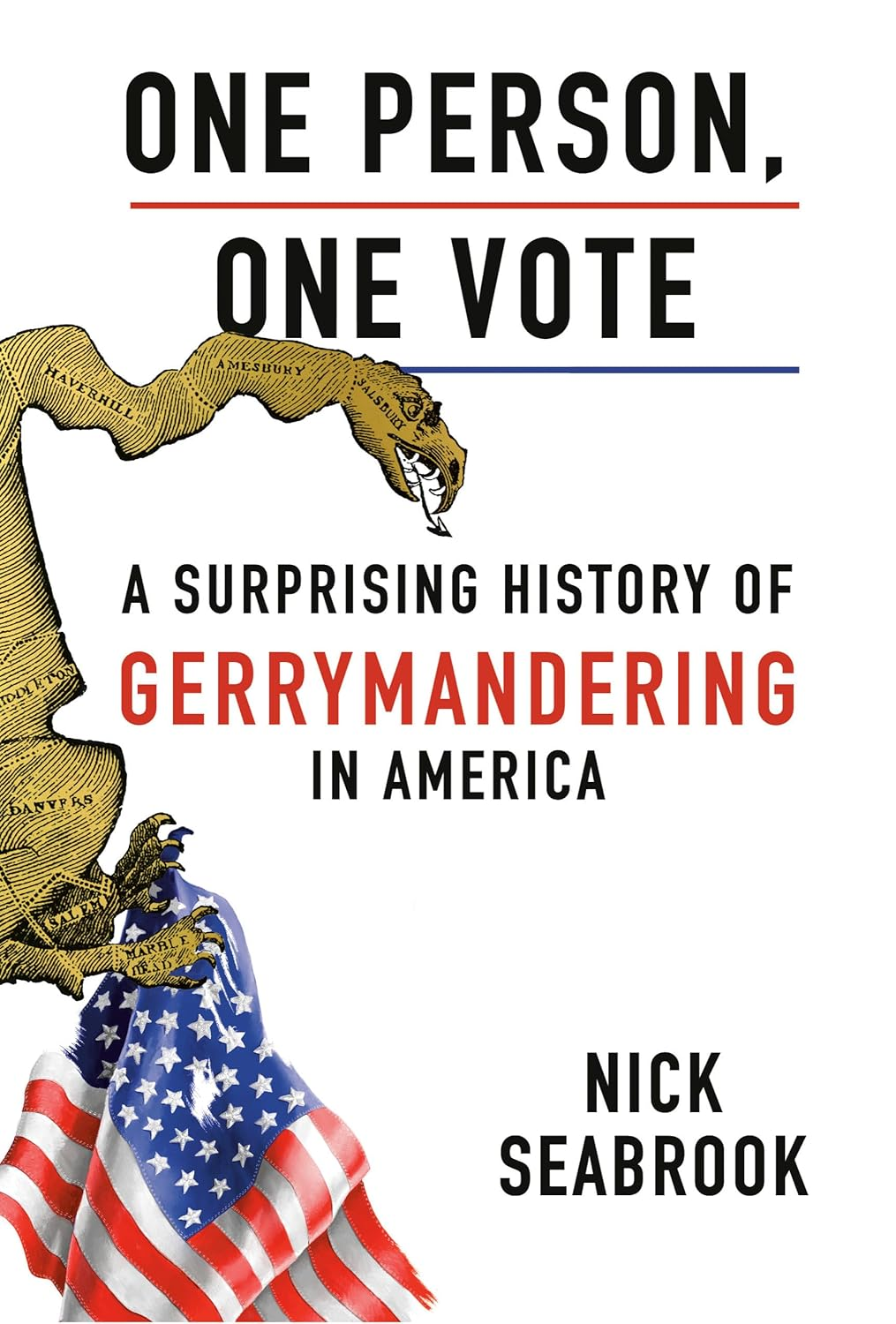Nick Seabrook, One Person, One Vote: A Surprising History of Gerrymandering in America


Nick Seabrook, One Person, One Vote: A Surprising History of Gerrymandering in America (Pantheon Books, 2022)
There is surely a good deal of truth in the old saw that one should not try to determine the nature or value of a book from its cover. But what about its title…or its subtitle? Can we tell much from that? Not here. Despite its title, Seabrook’s book is less an analysis of democratic equality than a sprawling, anecdote-rich chronicle of electoral manipulation in American history. In fact, the exact topic of what equality consists in for purposes of majoritarianism is almost never touched on, let alone discussed in detail.
But with respect to the subtitle the question is a bit tricker because of the ambiguity of the word “history.” In one sense of the word the book itself is a history (and a quite engaging one) about events that have occurred in the past. But a “history” can also be the historical processes themselves. Here, Seabrook (and/or his publisher) presumably intended to suggest that the surprising aspects are to be found in the events involved in the development of the American gerrymander rather than that the book is other than what one would expect. Because One Person, One Vote isn’t actually focused distinctly on gerrymandering, it manages to be a quite surprising history book.
Okay, enough on the matter of title. Suffice it to say that while gerrymandering is discussed quite frequently in it, that subject shouldn’t actually be called the book’s main topic. In fact, to put the matter harshly, Seabrook lacks definitional discipline regarding what constitutes a gerrymander, and his main topic isn’t really gerrymandering specifically, but electoral mischief-making of various types through the years.
This is not to say that he has not given us a good book on American history. There is a mountain of fascinating anecdotes here (which I imagine are among its author’s favorite collectibles) from American political history. We hear, for example, about James Madison getting his ears frostbitten during his campaign for Congress. There is a discussion of just how Jefferson’s contemporaries came to learn that he was engaged in a sexual relationship with one of his slaves. We learn that it was President Tyler who first came up with the idea of issuing a signing statement along with an enacted bill. We are told about Harrison’s views of hard cider and log cabins. We even find out that the actor Woody Harrelson’s father was a contract killer who was responsible for the first murder of a sitting judge in the 20th Century! The batch of reproduced newspaper cartoons depicting the cuckoo districts proposed by Democrats to obliterate their Whig foes in the Ohio election of 1842 is particularly entertaining. And there is a LOT of information here about a rogue named George Burrington, twice Governor of Virginia in the 1720s and 30s who, in a chapter entitled “The First Gerrymander,” arranged something that we are told in that very chapter was NOT actually gerrymander at all because it involved malapportionment (the unequal population of districts receiving the same number of representatives).
I admit to being unfamiliar with many of the stories found here. And the book is absolutely rife with them. At times I was even reminded of Barbara Tuchman’s brilliant history of World War I. This is not to suggest that there is nothing to all these stories but humor, eccentricity, or intrigue. Many of them are connected in one way or another to something that does at least resemble gerrymandering. What there is no coherent commentary on, however, is the theory of democratic equality. And this may be wearying to readers whose primary interests are in that area. Justice Douglas’s “one person, one vote” remark is repeated numerous times, but if Seabrook has a view about what it means, or how that thesis conclusively connects to gerrymanders here, I couldn’t find it.
Part of the problem is that Seabrook employs a very broad definition of “gerrymandering” that sometimes includes not just malapportionment, but other structural manipulations of elections or other facets of democracy. While this approach offers a comprehensive narrative of electoral distortion in the U.S., it creates definitional ambiguities for those accustomed to a narrower, perhaps more technically accurate definition. In the Introduction Seabrook writes that “Gerrymandering requires manipulation. It is a departure from business as usual, from the traditional district-drawing principles of compactness, of contiguity, of following existing political boundaries, and of preserving the integrity of communities.”
Applications of that definition to Seabrook’s “surprising history” is problematic. First, it’s not obvious what “business as usual” ought to be followed regarding any of those matters at the dawn of American democracy. Worse, it’s not made entirely clear either why following such norms is important to determining a majority's will or why violating one or more of them must doom that assessment. To give one specific example of definitional mayhem, in several places Seabrook calls moving from single-winner district elections to at-large voting a form of gerrymandering, even though, of the “traditional principles” he earlier specified, only manipulation may be involved in such alterations.
Because of their inattention to minority representation, at-large elections, where 51% of the voters can get 100% of the representation, are certainly problematic. And with respect to at-large jurisdictions there is good sense to claims that the “one person, one vote” principle is violated. However, this is true of a number of other proportional representation schemes utilizing multi-member election systems as well, structures that are generally not thought to be intentionally pernicious. In any event, calling the elimination of all district lines “gerrymandering” is very misleading.
But one almost never gets away from the suggestions that every sort of intentional distortion of American democracy (and heaven knows there are thousands to choose from) has necessarily involved some kind of gerrymandering. In my own view, that’s not just erroneous, but is a potentially harmful position, because an exclusively geographic separation of voters, even via compact, contiguous, etc. districts is arguably a very bad way to determine what the people want. Such conception is based on the view that if we could draw ideal lines, since like-minded people (i.e. those mostly of the same political party (as well as race, ethnicity, religion, etc.), are bound to live near each other, democracy would be on the right footing. But even if it were really true that those with similar political positions must live near each other (which it isn’t, even in the U.S.’s largely two-party setting), the claim that intentionally crazy district lines are violative of the one-person, one-vote principle is hyperbolic. Unless districts differ in population so that votes carry unequal weight, it takes rhetorical gymnastics to show that they literally give citizens more or fewer votes. No doubt, numerous arguments with that goal have been brought to the U.S. courts over the years, but successes in making that case have been only occasional and short-lived.
Seabrook reasonably concludes here that since politicians cannot be trusted to draw district lines, independent, non-partisan commissions should be entrusted with that job. I absolutely agree that if there is no way in the U.S. to have anything but single-winner districts, the lines should be drawn by impartial designers. But as it is arguably no more difficult to do something about the exclusivity of single-winner districts than it is to put impartial commissions or appropriately designed algorithms in charge of geographical lines, it strikes me as inappropriate to put all one’s eggs in the anti-gerrymander basket. As said, even perfect districts (if such things were not fantasies) could not make for democratic systems in which “voice” is appropriately distributed–unless, of course, we also put computers in charge of “correctly” populating each district.$
As said, the extension of the term “gerrymander” is regularly expanded and narrowed here with the apparent goal of including as many fascinating historical anecdotes as possible. I was often reminded of historian James Burke’s old PBS series Connections. And there are so many remarkable stories included (I particularly enjoyed those regarding Harry Frankfurt’s intellectual development and the Andrew Johnson impeachment) that it is impossible–though quite tempting–to try to make an exhaustive list. But, interesting as they are, many of these tales have only the most fragile association to gerrymandering. To give another example, the author openly admits that while he sometimes calls mischief regarding the historical admission of new states gerrymandering, a lot of those activities have also met only the intentional manipulation standard.
In summary, while the book is excellent at detailing the mechanics and history of unscrupulous electioneering, it largely bypasses the opportunity to engage with foundational questions of democratic theory, such as the inherent tensions between single-member districting and majoritarian representation. Seabrook is correct, certainly, that gerrymandering has gotten both more effective and more injurious as available data and technical prowess have increased over the years. But, as the author himself points out, claims that recent redistrictings with partisan motives have been unconstitutional or even necessarily anti-democratic have often turned out to be quite controversial. I believe is partly a function of the fact that the whole notion of districts (or federalism of any kind) is difficult to comport with majoritarianism generally.# It’s true that Seabrook sometimes seems sympathetic to those, like Justice Frankfurt, who maintained that attempting judicial solutions is a bottomless rabbit hole. But, at least in my view, Seabrook’s faith that there are correct answers to single-member district problems that could be found if only smart, impartial commissions were put in charge, is just a baseless, happy dream.*
Readers focused on political science or democratic theory may therefore find this work’s treatment of core concepts disappointing. And, unfortunately, as a result of its poorly chosen title, One Person, One Vote is quite likely to be put on the wrong shelves in stores and taught in the wrong courses in colleges.
On the other hand, viewed as a popular history of electoral misconduct, the book succeeds very well. It is quite good, for example, on the application of advancing gerrymandering techniques to race, especially in post-Jim Crow Dixie. Seabrook is certainly a gifted recounter of remarkable incidents that have had momentous–and often unpredictable–effects on the subsequent structure of American democracy. And although he sometimes focuses more on personality quirks than on democratic principles or judicial findings, it remains the case that One Person, One Vote is pretty hard to put down.
_____________________________
# I have discussed that problem a bit here.
$ One might even argue that to really get exclusively geographic districts “right,” it would be necessary to drop contiguity completely!
* For some of my own thoughts on this subject, readers should take a look at my book, particularly chapters 7 and 8. Those with more technical proclivities might also enjoy this paper.

About the Author
Walter Horn is a philosopher of politics and epistemology.
His 3:16 interview is here.
Other Hornbook of Democracy Book Reviews
His blog is here